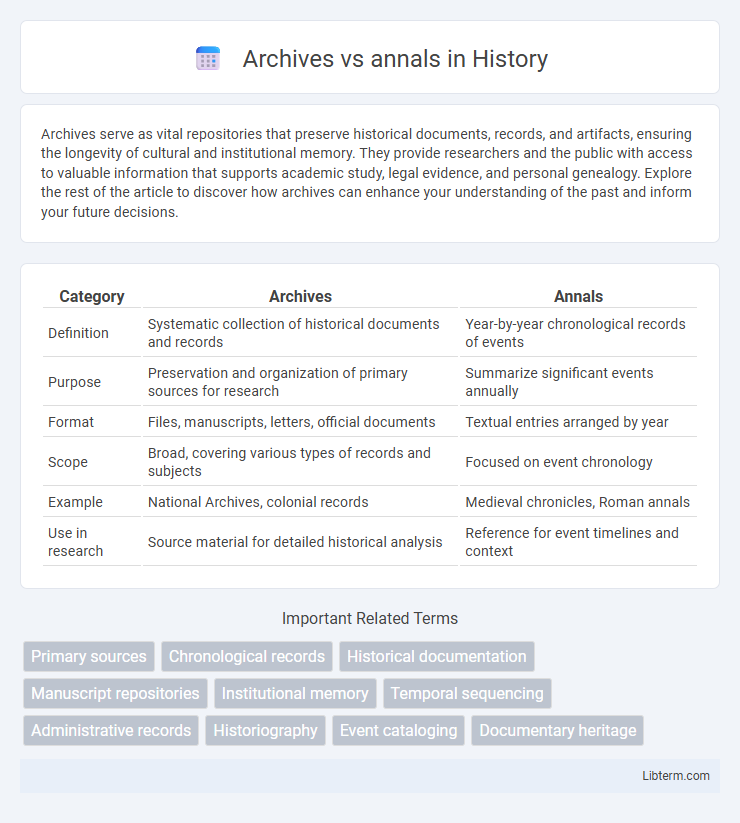Archives serve as vital repositories that preserve historical documents, records, and artifacts, ensuring the longevity of cultural and institutional memory. They provide researchers and the public with access to valuable information that supports academic study, legal evidence, and personal genealogy. Explore the rest of the article to discover how archives can enhance your understanding of the past and inform your future decisions.
Table of Comparison
| Category | Archives | Annals |
|---|---|---|
| Definition | Systematic collection of historical documents and records | Year-by-year chronological records of events |
| Purpose | Preservation and organization of primary sources for research | Summarize significant events annually |
| Format | Files, manuscripts, letters, official documents | Textual entries arranged by year |
| Scope | Broad, covering various types of records and subjects | Focused on event chronology |
| Example | National Archives, colonial records | Medieval chronicles, Roman annals |
| Use in research | Source material for detailed historical analysis | Reference for event timelines and context |
Understanding Archives and Annals
Archives represent systematically preserved collections of historical documents and records that provide comprehensive evidence of past events, organizations, or individuals. Annals are chronological records of events, often maintained yearly, that offer concise summaries of significant occurrences within a specific period. Understanding archives involves recognizing their role in preserving authentic primary sources, while annals serve as organized narrative accounts that help track historical developments over time.
Key Differences Between Archives and Annals
Archives are organized collections of primary source documents and records, preserving historical evidence with original context, while annals are chronological records or yearly accounts summarizing events over time. Archives provide raw, comprehensive data for research, emphasizing authenticity and original documentation; annals offer interpreted narratives, often highlighting significant occurrences in a linear format. The key difference lies in archives' role as repositories of primary materials versus annals serving as historical summaries or chronicles.
Historical Context of Archives
Archives serve as curated repositories preserving original historical documents, providing authentic primary sources essential for understanding past events and societal developments. Unlike annals, which are chronological records or summaries of events, archives contain diverse materials such as letters, manuscripts, and official records that offer deeper context and provenance. The historical context of archives reveals their role in safeguarding cultural heritage, enabling historians to reconstruct nuanced narratives beyond mere timelines.
The Role of Annals in Documentation
Annals serve as chronological records that document events year by year, providing a continuous historical timeline essential for understanding the progression of societies. Unlike archives, which store diverse forms of documentation including letters, photographs, and official records, annals specifically focus on sequential narrations of significant occurrences. Their role in documentation is crucial for historians seeking temporal context and tracking the development of political, social, and cultural changes over extended periods.
Organizational Structure: Archives vs Annals
Archives are systematically organized repositories where historical documents, records, and materials are classified and preserved according to specific categories, facilitating easy retrieval and long-term management. Annals, by contrast, are chronological records or yearly accounts of events, typically arranged in a linear sequence without comprehensive categorization, emphasizing the temporal progression of information. The organizational structure of archives prioritizes thematic or functional classification, while annals maintain a strict chronological order reflecting historical timelines.
Methods of Preservation and Accessibility
Archives utilize systematic cataloging and climate-controlled storage to preserve original documents, ensuring longevity and authenticity. Annals are typically chronological records maintained in simpler formats, often manuscripts or printed volumes, focusing on historical narrative rather than physical preservation. Accessibility in archives benefits from digitization and searchable databases, whereas annals require more traditional consultation methods, limiting ease of access for researchers.
Use Cases: When to Use Archives or Annals
Archives are ideal for preserving and managing primary source documents, official records, and historical evidence for research, legal reference, or institutional memory. Annals serve best for chronological summaries or annual records of events, useful in historiography, chronological studies, or reporting institutional milestones. Use archives when detailed, original materials are required; choose annals for concise, year-by-year event overviews.
Digital Transformation of Archives and Annals
Digital transformation of archives enhances access, preservation, and searchability of historical records by converting physical documents into digital formats. Annals, often chronological yearly records, benefit from digital platforms that enable interactive timelines and real-time updates. Embracing metadata standards and AI-powered indexing accelerates discovery and ensures the longevity of both archives and annals in the digital age.
Impact on Historical Research
Archives provide primary source documents that enable historians to reconstruct accurate narratives through original records, while annals offer chronological summaries that aid in understanding the sequence of events over time. The detailed, contextual information in archives allows for nuanced interpretations and critical analysis, fostering a deeper understanding of historical complexities. Annals, by presenting concise yearly entries, help identify long-term trends and patterns essential for macro-level historical research.
Future Trends in Record-Keeping
Archives are increasingly leveraging artificial intelligence and blockchain technology to enhance security, accessibility, and data integrity, ensuring long-term preservation of digital records. Annals, traditionally chronological and text-based, are evolving into interactive, multimedia timelines enriched by real-time data analytics and augmented reality interfaces. Future trends emphasize integrating advanced metadata frameworks and automated classification systems to optimize record-keeping efficiency and historical research accuracy.
Archives Infographic

 libterm.com
libterm.com